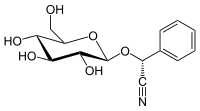Prunasin
 | |
| Names | |
|---|---|
| IUPAC name
(2R)-2-Phenyl-2-[(2R,3R,4S,5S,6R)-3,4,5-trihydroxy-6-(hydroxymethyl)oxan-2-yl]oxyacetonitrile | |
| Other names
(R)-Prunasin D-Prunasin D-Mandelonitrile-β-D-glucoside | |
| Identifiers | |
3D model (JSmol) |
|
| ChEBI | |
| ChemSpider | |
| ECHA InfoCard | 100.002.489 |
| EC Number | 202-738-0 |
| KEGG | |
PubChem CID |
|
| |
| |
| Properties | |
| C14H17NO6 | |
| Molar mass | 295.29 g·mol−1 |
Except where otherwise noted, data are given for materials in their standard state (at 25 °C [77 °F], 100 kPa). | |
| Infobox references | |
Prunasin is a cyanogenic glycoside related to amygdalin. Chemically, it is the glucoside of (R)-mandelonitrile.
Natural occurrences
Prunasin is found in species in the genus Prunus such as Prunus japonica or P. maximowiczii and in bitter almonds.[1] It is also found in leaves and stems of Olinia ventosa, O. radiata, O. emarginata and O. rochetiana[2] and in Acacia greggii.
It is also found in dandelion coffee, a coffee substitute.
Sambunigrin, a diastereomer of prunasin derived from (S)-mandelonitrile instead of it the (R)-isomer, has been isolated from leaves of the elder tree (Sambucus nigra)[3]
Toxicity
Prunasin is hydrolyzed to produce hydrogen cyanide. Plants containing prunasin may therefore be toxic to animals, particularly ruminants.[4]
Metabolism
Prunasin beta-glucosidase is an enzyme that uses (R)-prunasin and H2O to produce D-glucose and mandelonitrile.
Amygdalin beta-glucosidase is an enzyme that uses (R)-amygdalin and H2O to produce (R)-prunasin and D-glucose.
References
- ↑ Sanchez-Perez, R.; Belmonte, F. S.; Borch, J.; Dicenta, F.; Møller, B. L.; Jørgensen, K. (2012). "Prunasin Hydrolases during Fruit Development in Sweet and Bitter Almonds". Plant Physiology. 158 (4): 1916–32. doi:10.1104/pp.111.192021. PMC 3320195. PMID 22353576.
- ↑ Nahrstedt, Adolf; Rockenbach, Jürgen (1993). "Occurrence of the cyanogenic glucoside prunasin and II corresponding mandelic acid amide glucoside in Olinia species (oliniaceae)". Phytochemistry. 34 (2): 433. doi:10.1016/0031-9422(93)80024-M.
- ↑ Andrew Pengelly (2004), The Constituents of Medicinal Plants (2nd ed.), Allen & Unwin, pp. 44–45, ISBN 1-74114-052-8
- ↑ Peter R. Cheeke (1989). Toxicants of Plant Origin: Glycosides. 2. CRC Press. p. 137.